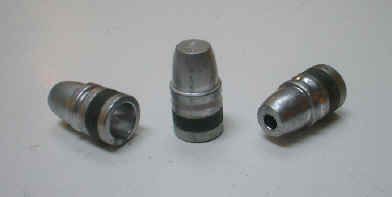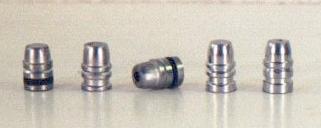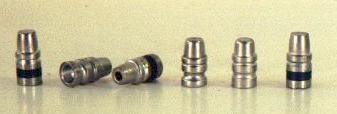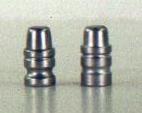Variations on a Near Perfect Theme By Glen E. Fryxell
Mozart was a genius in his ability to take a theme, build upon it, twist it slightly, and embellish it, creating beautiful music based on variations of that central theme. Many other musicians, like Scott Joplin, Bob Wills, Duke Ellington and Al DiMeola, have mastered the art of theme variation in more recent years, and the world is a richer place for their efforts. All have made a joyous noise.
The concept of variations on a theme is hardly isolated to the composer's creative itch. One of my favorite examples has far less etheral origins. Elmer Keith was an earthy genius. He was a simple Idaho cowboy who understood the inner workings of a sixgun far better than most. He was smart enough to solve some of the problems encountered with those early sixguns and ammo, and vocal (and persistent!) enough to get the industry to manufacture some of his better ideas. The Keith SWC is the landmark by which all other revolver bullets are judged.
I like to tease some of my shooting friends who favor GC bullets about shooting bullets that need training pants. This is all meant as good-natured ribbing, of course, but Elmer Keith didn't care for GC bullets and I tend to share his opinion. Not that there's anything wrong with GC cast bullets, I have a fair number of GC moulds and do periodically shoot GC bullets, I just don't see an overwhelming need for them for routine sixgun shooting (up to say about 1600 fps). Mr. Keith designed his SWC's to be plain-based, have one large, square-cornered grease groove, a wide, beveled crimp groove, a full-diameter wadcutting front driving band, an ogive that would allow for long-range stable flight and a meat-crushing meplat. The fact that his designs are as widely used (and as widely copied) as they are today, three-quarters of a century later, is thunderous testimonial to how well his design achieved his stated goals -- accuracy at all ranges, cut clean holes through both paper and meat, and be able to shoot all day with no leading. Simple, pragmatic and deadly. He took his basic design and once he was convinced that it indeed lived up to his vision, he commissioned variations on that theme, in different calibers and configurations. More recently others have taken Keith's concepts and put their own refinements on his designs. Taken as a whole, this group has proven itself to be some of the greatest sixgun bullets of all time.
The Lyman numbering scheme is pretty straightforward. The first 3 digits are the nominal bullet diameter, and the second group of 3 digits are the sequential model number for that design (there are a few models numbers that are out of sequence, but we'll ignore those for the current discussion). So a 429421 is a bullet with a diameter of .429" and is the 421st design adopted by Lyman (or Ideal), and 429421 is where the Old Master started his glorious theme back in 1928. Mr. Keith knew he wanted a 250 grain, plain-based semi-wadcutter. He drew up the now famous meplat and ogive for his SWC, gave it 3 equal width driving bands, a deep square-cut grease groove and a hearty, beveled crimp groove, and the perfect .44 Special bullet was born. Driven to 1200 fps (and later, much faster), this bullet became a cornerstone of handgun history, and has been directly responsible for the genesis of generation after generation of .44 fanatics over the years. From bullseyes to bull elk, Keith did it all with this bullet loaded to 1200 fps with 17.0 grains of 2400.
Enter stage right, one lawman from the dusty, desert southwest. Skeeter Skelton tried Elmer's unprecedented .44 Special loads and found them to be excessive for his use in law enforcement. Skeeter set about performing his own series of experiments with the 429421 and settled on a very practical (and economical) load of 7.5 grains of Unique for about 900 fps. Both of these loads are as good today as they were 50 years ago.
My favorite .44 Special load with the 429421 is 10.0 grains of W540 or HS-6. This load delivers almost 900 fps from my pet 3" Lew Horton S&W 624, and as much as 100 fps more from longer barrels. Very accurate, very reliable, very useful, and very, very much fun.
With the solid SWC having proven itself a success, Elmer later tried a variation on the Keith SWC theme to see how an expanding version would perform on game. Thus the 429421 HP came to pass. After much experimentation, Mr. Keith settled on an alloy of 16-to-1 (lead to tin) for his HP bullets, and he drove them to 1200 fps with 17.0 grains of 2400 (when loaded in modern solid head cases), sparked with a standard primer.

The Lyman 429421 family
the original SWC, the 429422 Hollow-Base and the 429421 Hollow-Point
So cast and launched, expansion and weight retention were excellent, and the 429421 HP proved itself a killer of the first order. When the .44 Magnum came along in 1956, he promptly loaded this bullet over 22.0 grains of 2400 and declared it Good. Elmer Keith shot, and hunted with, both the SWC and HP versions of his beloved 429421 for roughly 60 years. No stronger endorsement of a handgun bullet can ever be made.
My own experience with the 429421 HP is somewhat more limited, I've only been shooting it for about 10 years. When I shoot it in .44 Magnum, I cast it with wheelweight alloy with about 2% added tin and the bullets weigh about 235 grains. Loaded over 23.5 grains of W296, it's good for 1350 fps from a 6" S&W Classic Hunter and expansion is positive. Anymore, I shoot this bullet mostly in .44 Specials. For these velocities, I generally cast these HP's from 25-to-1 alloy and load them over 10.0 grains of either W540 or HS-6 for 950 fps from a 7 1/2" custom Blackhawk. Big varmint medicine!
Now keep in mind that when Mr. Keith was designing his bullets, manufacturing tolerances were a little looser than they are today, particularly in the area of a revolver's cylinder throats. A fairly common practice in that day was to make bullets with a hollow base so that the expanding gases of the powder charge would force the bullet's base to obturate in both the throat and the bore, even if those diameters didn't exactly match up. Viewed in that light, it comes as no surprise that his next design was simply 429421 with a hollow-base (something that would not be possible with a GC design). Thus, the 429422 was born. This bullet was mentioned briefly in Sixguns, where it was described as weighing 235 grains. Bullets drop from my mould closer to 225 grains when cast of wheelweight alloy (the difference is likely due to the different alloys used). In my experience with this bullet, it absolutely drives tacks loaded on top of 6.5 grains of Unique for about 750 fps. On top of that, this load makes a great practice/plinking load for the delightful little S&W 696 -- and it shoots to the same point of impact as the Cor-Bon duty load.
The next number in the Keith SWC line was the 454423, the cute little 238 grain SWC made for the .45 Auto-Rim and .45 ACP. Elmer liked to load this stumpy bullet rather stiffly for the N-frame Smiths, commonly up to about 1100 fps. I don't shoot this bullet much in either .45 AR or .45 ACP (but Charles Graff has, and I recommend you read his story), but I do like it very much in .45 Colt, where I generally shoot it over 8.5 grains of W231 for 1000 fps from a 6" S&W Model 25. Accuracy is very good and with my homemade moly lube, there is no leading at all. This is a dandy plinking and varmint bullet.
Mr. Keith wanted a SWC like the 429421 for the sixgunner's sixgun -- the .45 Colt. He kept the weight about the same, thereby compressing the bullet and driving bands somewhat. The result was the 454424, nominally 255 grains in weight (mine weigh closer to 250 grains). At whatever weight, this bullet is a classic thoroughbred. The time-honored load for the 454424 in the .45 Colt is 7.5 grains of Unique for 800 fps. Elmer also liked 18.5 grains of 2400 for 1100+ fps (again, with standard primers). My own tastes with this bullet run much simpler -- I load it over 9.0 grains of Universal Clays for 900-975 fps (depending on barrel length). This bullet was designed to be an accurate and humane killer, and it lives up to its progenitor's vision beautifully.
A little while later Mr. Keith commissioned a HP version of this SWC, the 454424 HP. This bullet was only mentioned in passing in Sixguns, but in that brief reference it was described as ripping big, deep holes in meat.
I generally cast this bullet of 25-to-1 alloy (where it weighs 242 grains) and load it over 9.0 grains of Universal Clays (950 fps) or 9.0 grains of W231 (1000 fps). It is a very accurate and hard-hitting hunting bullet.
It can be argued that with a meplat as large as it is on the .45 Keith SWC, why would any expansion be necessary? But then again, why not? Is there such a thing as too much frontal surface? Methinks not. I like dancin' with Big Mama Meplat!
In recent years, the .45 caliber Keith SWC design has been copied, modified and made-over by several mould-makers. Some of these newer designs are simply wannabees, some are real winners. One of the more notable to my eye is the RCBS-255-SWC, which took the basic 454424 design and gave it a thicker base band, and hence more weight (about 266 grains when cast of wheelweights). I never really understood why Elmer Keith designed a shorter bullet for the .45 Colt than he did for the .44 Special, but then Taffin explained to me that it was because of the longer case length of the .45 Colt over the .44 Special and the need to make the 454424 fit in the Colt SAA cylinder. The RCBS SWC makes up much of this length difference and just might be the best all-round bullet for the .45 Colt.
|
An assortment of .45 caliber SWCs of the Keith style: the Lyman 454423, the 454424, the 454424 HP, the RCBS 45-255-SWC, and the RCBS 45-270-SAA. |
Any of the .45 Colt loads previously mentioned also apply here, but another one worth mentioning is 14.0 grains of HS-7 with a magnum primer (not for Colt SAAs or clones). This load is good for about 1050 fps from a 7 1/2" Ruger Blackhawk, and is very accurate. A real thumper!
Dave Scovill (of Handloader Magazine) took this evolution one step further and took the .45 Keith SWC back to its roots -- full-length and 3 equal width driving bands. Thus was born the RCBS 45-270-SAA. My mould drops bullets that weigh 282 grains when cast of wheelweight alloy. Now THIS is a real hunting bullet! Editor Scovill likes to shoot his bullet over either 16.5 grains of 2400 or 13.0 grains of Blue Dot. The most accurate load I have found to date is 13.0 grains of HS-6, which generates 1050-1100 fps from my Blackhawks (do not shoot this load in SAA‚s, I would guess this load is probably running around 22,000 psi, which I consider to be maximum for the S&W N-frame .45 Colts, obviously the Rugers can handle these pressures with ease). A Keith meplat, coupled with over 280 grain of bullet metal, traveling at the speed of sound -- there are very few critters in North American capable of stopping a bullet of that description. I really like this bullet.
Next up on Elmer's design list was a Keith SWC for the .38 Special and .357 Magnum. Here's a big surprise, he designed it to be full-length and have 3 equal width driving bands! (OK, so maybe you're not surprised....).
The 358429 has something of a mixed history since it wouldn't function in all revolvers (the long ogive made it too long to fit in some revolvers when crimped in the crimp groove, requiring that the crimp be placed over the forward driving band). In spite of this hurdle, it became one of the all-time classic .357 Magnum bullets. In addition, this was the bullet that Elmer Keith preferred for the .38/44 Heavy Duty, loaded over stiff charges of 2400 in .38 Special cases. For regular .38 Special loads, he favored 5.0 grains of Unique (about 850 fps), and for .357 Magnum loads he tended to use 14.5 grains of 2400 (the current recommended max is 13.5 grains of 2400). Weighing 170 grains when cast with wheelweights, I generally load this bullet over 13.0 grains of H110 in .357 Magnum cases for about 1200 fps. So loaded, this makes one of the best long range plinking rounds available. This bullet displays remarkably stable flight over a 1/4 mile or more. If you want to learn long range sixgunning as taught by Elmer Keith, this is an excellent bullet to start with.
As with its .44 cousin, a hollow-based version of the 358429 was quickly drawn up, and that is exactly what the 358431 is. In Sixguns, Keith refers to this bullet as weighing 160 grains, but they drop from my mould at 153 grains when cast of wheelweight alloy (again, the difference is likely due to the different alloys used). Some of the older revolvers chambered for the .38 S&W cartridge have a reputation for having somewhat oversized bores (commonly .360‰), and I picked up this mould as a way of dealing with such a barrel, should one ever follow me home. In the mean time, I've tried this bullet with a variety of loads in .38 Special cases, and they all seem to shoot well. Not surprisingly, 4.0 grains of Bullseye performs quite well in this application, followed closely by the usual cast (W231, HP-38, Unique, etc.). The hollow-base of the 358431 obturates very effectively, making this a very clean shooting bullet. In fact, it seals the bore so well that it even cleaned out light leading left by my previous test loads!
Not surprisingly, the hollow-point version of this Keith SWC wasn't far behind. This bullet was offered in two slightly different variations -- the 358429 HP, which weighs 160 grains cast from wheelweight alloy, and the 358439, the 154 grain version that was eventually serialized with its own unique mould number (the difference between these two bullets is in the diameter and depth of their cavities). These two variations on the Keith SWC define the perfect handgun varmint bullet (in fact, this bullet was Mr. Keith‚s first HP design and it proved to be such a tremendous success that he went back and designed the HP versions of his .44 and .45 SWCs discussed earlier). Mr. Keith liked this bullet loaded over 5.3 grains of Unique in .38 Special cases (for about 950 fps) and 15.0 grains of 2400 in .357 Magnum cases (for over 1300 fps), and it‚s easy to share his enthusiasm for these loads. At 950-1000 fps, expansion is positive and even big-bodied, husky Montana jack rabbits just fold up right now when hit with this bullet. At magnum velocities, well, rodents just explode. I generally load either of these two HP‚s over 8.5 grains of HS-7 in .38 Special cases (1050 fps) and 14.0 grains of H110 in .357 Magnum cases, for about 1300 fps.
|
The family of .38 Keith SWCs: the Lyman 358429 SWC, the Hollow-Base 358431, the Hollow Point 358439, the 358477 (150 grain version), the 358477 (158 grain version), followed by another 358429 |
One last design to come down the pike that merits inclusion with its .38 caliber brethren is the enigmatic 358477. Now Elmer wouldn't care for its radiused grease groove, but the 150 grain version of this bullet has 3 equal width driving bands, a hearty grease groove, a right proper crimp groove and the classic Keith SWC ogive. This is one of the best .38 Special bullets that's ever been made. There is also a 158 grain version of the 358477 in which the grease groove is significantly smaller, the driving bands are wider and of unequal width, the crimp groove now is nothing more than another radiused grease groove, and the forward driving band is pushed forward, shortening the ogive and forcing more of the bullet down into the case (see photo). The 150 grain version has proven itself to be more accurate in my guns. When loaded over 5.4 grains of Unique it delivers right at 1000 fps from a 6" K-38 Masterpiece and makes an exquisitely accurate small game/varmint load. Also quite accurate is 4.5 grains of Red Dot, for slightly less velocity.
|
A close up showing the differences between the 150 grain version of the 358477 (left) and the 158 grains version of 348477 (right) |
And then there are the .41's, the .40's, and the .32's; and now there are .475's and .50's to add to the list. There are light Keith-style SWC's, heavy Keith-style SWC's, and the list just keeps on growing. The variations on this theme seem to be virtually endless. The Keith SWC's are truly great bullets. We are indeed blessed to have had such a teacher as Elmer Keith.
I believe I'll take the fruits from these variations on this near perfect theme, and go out to a remote, sunny stretch of BLM land and make my own kind of joyous noise. That should be music to the Old Master's ears.


